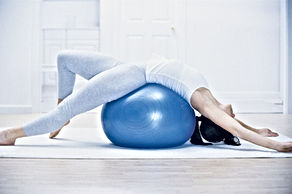





Pilates for injuries
Many injuries are caused by muscular imbalances within our bodies. And many things cause these imbalances - our posture, the way we walk, bend over, sit, lie down, or work out - basically the way we move. Most of us move incorrectly in some way or another, which puts too much pressure on some muscles and weakens others, causing an imbalance. Take the back, for example: the way we move may put too much pressure on the spine, while weakening the pelvic muscles in the front of the body or vice-versa. Either scenario creates an imbalance, which means the body is much more perceptible to serious strains, pulls, tears or worse.
Pilates exercises promote an even musculature throughout the body by strengthening the core. The core is considered the "center" of the body and consists of the deep abdominal muscles along with the muscles closest to the spine. Pilates also stresses spinal and pelvic alignment, which is critical in getting us to move the way we're supposed to move to avoid injury. Pilates focuses on rehabilitating in an effective way with low-level skill development and progressive loading through the affected area. Rehabilitative programs will begin with a focus on strengthening the deep supporting structures of the body, and then progress to more complex movements that integrate the injured area into full functional and sport-specific movement patterns.
Throughout the progression, biomechanical compensations are identified and specific corrections or modifications are given to improve the quality of the movement patterns and to strengthen the mind-body connection.
Pilates offers clients a variety of options and movement experiences, which is integral to their motivation, interest and recovery.
Pilates & arthroplasty
Arthroplasty is a surgical procedure to restore the function of a joint. A joint can be restored by resurfacing the bones. An artificial joint (called a prosthesis) may also be used.
Various types of arthritis may affect the joints. Osteoarthritis, or degenerative joint disease, is a loss of the cartilage or cushion in a joint, and is the most common reason for arthroplasty.
Arthroplasty may be used when medical treatments no longer effectively relieve joint pain and disability. Some medical treatments for osteoarthritis that may be used before arthroplasty include:
-
Anti-inflammatory medicines
-
Pain medicines
-
Limiting painful activities
-
Assistive devices for walking (such as a cane)
-
Physical therapy
-
Cortisone injections into a knee joint
-
Visco supplementation injections (to add lubrication into the joint to make joint movement less painful)
-
Weight loss (for obese people)
-
Exercise and conditioning
People who have arthroplasty generally have substantial improvement in their joint pain, ability to perform activities, and quality of life.
Most joint surgery involves the hip and knee, with surgery on the ankle, elbow, shoulder, and fingers being done less often.
There may be other reasons for your healthcare provider to recommend arthroplasty.
The above article is from
http://www.hopkinsmedicine.org/healthlibrary/test_procedures/orthopaedic/arthroplasty_92,P07677/
For further information, please do not hesitate in contact us.
info@connecthealthandfitness.com
Exercises after hip replacement
Pilates for rehabilitation



